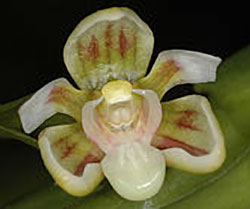New species of orchids discovered in Papua New Guinea
New species of orchids discovered in Papua New Guinea
mongabay.com
November 17, 2006
Last month, environmental group WWF announced the discovery of eight orchid species previously unknown to science in the tropical forests of Papua New Guinea (PNG). PNG, which covers roughly half the island of New Guinea, has the more species of orchid than any country in the world.
Over the course of three orchid surveys in PNG’s Kikori region between 1998 and 2006, WWF collected some 300 species of orchids, including eight which have been confirmed as new the science, and 20 that may be undescribed species.
“The island of New Guinea is an incredible goldmine of orchids,” said Wayne Harris, a botanist from Queensland Herbarium in Australia and one of the world’s leading authorities on orchids. “There are over 3,000 known species found here with countless varieties undoubtedly yet to be discovered.”
 One of eight new orchid species (Cadetia Kutubu) recently discovered in Papua New Guinea. © WWF / Wayne Harris |
“The discovery of such a large number of new orchid species is incredibly exciting,” said WWF Forest Ecologist Olo Gebia. “The sad reality is that many of these plants, including those which may contain cures to some of the world’s most deadly diseases, may become extinct before they have even been discovered. This gives even greater urgency to ensuring the long-term conservation of this remarkable region.”
WWF is working with the Kutubu Joint Venture Partnership, a consortium of companies managing oil and gas fields in the Kikori Basin, to conserve the Kikori region. WWF says that its engagement with energy firms “demonstrate[s] best practice in the oil and gas operations in the area.” The partnership has been active since 1996.
Orchids: Globally there are some 25,000 described species of orchid, though another 800 are added every year. There are more than 100,000 hybrids and cultivars that have been produced by horticulturists.
Papua New Guinea: Papua New Guinea is famous for its dense rainforests and unmatched cultural diversity — more than 800 languages are spoken in the country. While PNG was spared much of the forest destruction of its neighbors, in recent years, legal and illegal logging has increased. Forest clearing for agriculture is also a significant source of deforestation. Primary forest loss is estimated at 250,000 hectares per year according to the United Nations.
SPECIES DISCOVERY NEWS
Photos of newly discovered species in Brazil’s Amazon rainforest — 9/27/2006
Brazil has announced the creation of a Amapa State Forest, a 5.7 million acre Amazon protected area larger than the state of New Jersey. According to Conservation International (CI), “the designation protects a crucial section of the Amapa Biodiversity Corridor of northern Brazil, which includes some of the most pristine remaining Amazon forest.” The Amapa Biodiversity Corridor — which includes a variety of ecosystems including tropical forests, mangrove swamps, savannah, and wetlands — is home to more than 1,700 species of animals and plants, including 430 species of birds, 104 species of amphibians, 124 reptile species and 127 mammal species, including 62 bat species, according to biological surveys conducted by Conservation International (CI) and the Amapa State Institute for Research. At the core of the Amapa Biodiversity Corridor is Tumucumaque National Park, the world’s largest tropical forest park.
Previously undiscovered species found in Tanzania — 6/22/2006
The first field surveys of the Rubeho Mountains in Tanzania revealed over 160 animal species–including a new species of frog and eleven endemic species–according to an article published in the African Journal of Ecology this month. The findings elevate the importance of protecting this biologically-rich wilderness area and the broader Eastern Arc Mountain range from destructive activities underway such as clear-cutting for agriculture, logging and poaching.
3 new lemurs named in Madagascar — 6/21/2006
To recognize an internationally renowned primatologist and champion of Madagascar’s unique biodiversity, scientists who discovered three new species of mouse lemur on the island nation have named one in honor of Russell A. Mittermeier, the president of Conservation International.
6 species of frogs discovered in Laos — 4/20/2006
Six new species of frogs have been discovered in the Southeast Asia nation of Lao PDR, according to the Bronx Zoo-based Wildlife Conservation Society (WCS). Three newly discovered frog species are described in the recent issue of Copeia, the journal of the American Society of Herpetologists and Ichthyologists. WCS says that little is known about the new frogs, other than the location they were found and how the compare morphologically to similar species.
Pictures of new species discovered in New Guinea — 2/7/2006
A team of scientists led by Conservation International (CI) found dozens of new species in a survey of New Guinea’s Foja Mountains. The December 2005 trip by a team of U.S., Indonesian, and Australian scientists discovered new species of frogs, butterflies, plants, and an orange-faced honeyeater, the first new bird from the island of New Guinea in more than 60 years.
In search of Bigfoot, scientists may uncover unknown biodiversity in Malaysia — 2/1/2006
Malaysian scientists are scouring the rainforests of Johor state in search of the legendary ape-man Bigfoot, supposedly sighted late last year. But they are more likely to encounter some less fantastic but unique creatures that dwell in these still unexplored ecosystems.
This article uses quotes from a WWF news release.